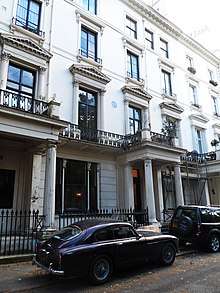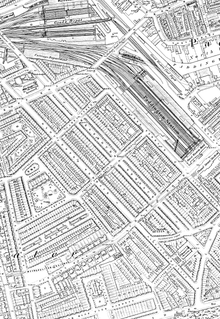Westbourne Terrace
Westbourne Terrace is a street in the Paddington district of the City of Westminster in west London. The street runs between Westbourne Bridge in the north and the junction of Westbourne Crescent and Sussex Gardens in the south and was developed between 1839 and the late 1850s. It has been described as one of the "finest streets in London" and the "grandest of the Bayswater terraces".[4] The street is not to be confused with Westbourne Terrace Road which runs north from Westbourne Bridge into Little Venice, and a large number of other Westbourne streets in the area.
 60 Westbourne Terrace | |
 Westbourne Terrace (centre, diagonal) | |
| Type | Residential terraced houses |
|---|---|
| Area | West London |
| Location | Westbourne |
| Coordinates | 51.5159°N 0.1797°W |
| Construction | |
| Construction start | 1839 |
| Completion | Late 1850s |




History
Westbourne Terrace is named after the local River Westbourne, a tributary of the River Thames, and is one of a large number of Westbourne streets in the area. In 1868, Cusack Roney wrote in Rambles on Railways, that there were 19 "Westbourne" streets listed in the London Postal Guide.[5]
The street was developed between 1839 and the late 1850s. Architects working in the area included Matthew Wyatt, George Ledwell Taylor, and Thomas Marsh Nelson who was particularly active in Westbourne Terrace in the 1840s on behalf of the builder William Kingdom.[6]
Buildings
Westbourne Terrace is a long tree-lined avenue, almost wholly made up of four storey stucco terraced houses divided by the cross streets, Bishop's Bridge Road, Cleveland Terrace (formerly James Street), Chilworth Street, and Craven Road. The street has more modern buildings north of Bishop's Bridge Road. Westbourne Terrace Mews runs north from Cleveland Terrace but does not join Westbourne Terrace. Each terrace has its own private access road at the front. According to Nikolaus Pevsner, the architecture of Westbourne Terrace shows the transition from the classical style to the Italianate.[6]
East side
Numbers 1 to 31 were built by Robert Palmer Browne by 1849.[6] They are grade II listed.[7] Irish painter Patrick Swift lived at number nine in the mid-twentieth century.[8] Canadian author Elizabeth Smart also lived at number nine, in a different flat.[9]
Numbers 33–77 were developed by William Kingdom, whose architect was Thomas Marsh Nelson.[6] They are grade II listed.[10] Admiral Charles Bethune lived at number 53.[11]
The terrace of 79–119 was built around 1840, probably by William King and William Kingdom. It is grade II listed.[12] Richard Cobden, politician and social reformer, lived at number 103.[13]
Numbers 121 to 141, later the Dorland Hotel, and now offices, is grade II listed. The terrace was built around 1840, probably by William King and William Kingdom.[14]
The residential Brewer's Court[15] and offices occupy the northern end of Westbourne Terrace between Bishop's Bridge Road and Westbourne Bridge.
West side
Numbers 2-30 were developed by William King in the 1840s.[6] Numbers 6–30 are grade II listed.[16] Art critic R. H. Wilenski was born at number 16 Upper Westbourne Terrace in 1887.[17]
Numbers 32 to 68 were developed by William Kingdom, whose architect was Thomas Marsh Nelson.[6] They are grade II listed.[18] Civil engineer Charles Manby (1804–1884) lived at number 60.[19] Uriah Maggs opened his first bookshop at 44 Westbourne Terrace North in 1844.[20] Field-Marshal Sir William Robertson (1860–1933) lived at number 88 during his retirement.[21]
Numbers 70–106 and 108 to 136 are grade II listed. They were built around 1840, probably by William King and William Kingdom.[22][23]
Holy Trinity church once stood on the west side on the corner with Bishop's Road, now Bishop's Bridge Road. It was built in 1844-1846 to a design by Thomas Cundy.[2] Trinity Court now stands on the site.
Brunel House, originally Trinity Lodge, an Italiante stucco villa at number 140 on the southern corner with Orsett Terrace is grade II listed. It was designed by George Ledwell Taylor in 1843-1848.[1]
Westbourne Court, a mansion block completed in 1938, is on the northern corner with Orsett Terrace at the north end of Westbourne Terrace.[24]
See also
- Augustus Prevost, Baronet Prevost of Westbourne Terrace
References
- Historic England. "140, Westbourne Terrace W2 (1267518)". National Heritage List for England. Retrieved 27 July 2018.
- The Church of the Holy trinity, Bishop's Road Paddington. Sanders of Oxford. Retrieved 28 July 2018.
- Ordnance Survey, 1869. Digimap. Retrieved 27 July 2018. (subscription required)
- Ben Weinreb, Christopher Hibbert (2010). The London Encyclopaedia (3rd Edition). ISBN 1405049251.
- Roney, Sir Cusack Patrick. (1868). Rambles on Railways. London: Effingham Wilson. pp. 36.
- Pevsner, Nikolaus & Bridget Cherry. (2002). The Buildings of England: London 3: North West. New Haven & London: Yale University Press. pp. 684–686. ISBN 0300096526.
- Historic England. "196B and C, Craven Road W2, 1-31, Westbourne Terrace W2 (1066125)". National Heritage List for England. Retrieved 28 July 2018.
- Quinn, Antoinette. (2003). Patrick Kavanagh, A Biography (Revised ed.). Gill Books. p. 669. ISBN 978-0-7171-6374-8.
- Barker, Christopher (20 August 2006). "Christopher Barker on his parents, George Barker and Elizabeth Smart". The Guardian. Retrieved 28 July 2018.
- Historic England. "33–77, Westbourne Terrace W2 (1222823)". National Heritage List for England. Retrieved 28 July 2018.
- "Births. » 29 Dec 1860 » The Spectator Archive". spectator.co.uk. Retrieved 3 August 2018.
- Historic England. "79–119, Westbourne Terrace W2 (1066126)". National Heritage List for England. Retrieved 28 July 2018.
- Paddington: Bayswater. British History Online. Retrieved 6 August 2018.
- Historic England. "Dorland Hotel, Westbourne Terrace W2 (1357362)". National Heritage List for England. Retrieved 28 July 2018.
- Brewer's Court. Buildington. Retrieved 31 July 2018.
- Historic England. "6-30, Westbourne Terrace W2 (1267569)". National Heritage List for England. Retrieved 28 July 2018.
- Wilenski, Reginald Howard. by Dennis Farr, Oxford Dictionary of National Biography, Oxford University Press, 23 September 2004. Retrieved 12 July 2018. (subscription required)
- Historic England. "Royal Eagle Hotel (1066127)". National Heritage List for England. Retrieved 28 July 2018.
- "Manby, Charles (1804–1884) – English Heritage". www.english-heritage.org.uk. Retrieved 28 July 2018.
- "Maggs Brothers: A Note" The Private Library. Vol. 4, No. 8 (October 1963), pp. 161-162 (p. 161).
- Robertson, Sir William Robert, first baronet. Oxford Dictionary of National Biography. Retrieved 6 August 2018.
- Historic England. "70–106, Westbourne Terrace W2 (1222912)". National Heritage List for England. Retrieved 28 July 2018.
- Historic England. "108-136, Westbourne Terrace W2 (1066128)". National Heritage List for England. Retrieved 28 July 2018.
- Westbourne Court. Buildington. Retrieved 6 August 2018.
External links
![]()